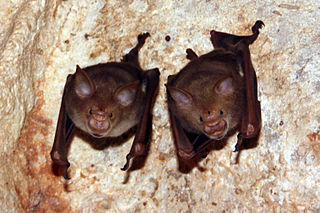
Riversleigh World Heritage Area is Australia's most famous fossil location, recognised for the series of well preserved fossils deposited from the Late Oligocene to more recent geological periods. The fossiliferous limestone system is located near the Gregory River in the north-west of Queensland, an environment that was once a very wet rainforest that became more arid as the Gondwanan land masses separated and the Australian continent moved north. The approximately 100 square kilometres (39 sq mi) area has fossil remains of ancient mammals, birds, and reptiles of the Oligocene and Miocene ages, many of which were discovered and are only known from the Riversleigh area; the species that have occurred there are known as the Riversleigh fauna.
Barawertornis tedfordi was a dromornithid (mihirung), a large flightless fowl hailing from Late Oligocene to Early Miocene. The only species in the genus Barawertornis, its fossil remains are found in strata of the Riversleigh deposits located at two sites in Northwestern Queensland, Australia.

The orange leaf-nosed bat is a bat in the family Hipposideridae. It is the only living species in the genus Rhinonicteris which is endemic to Australia, occurring in the far north and north-west of the continent. They roost in caves, eat moths, and are sensitive to human intrusion.

Rhinonicteris is a genus of leaf-nosed microbats, represented by fossil taxa found at Riverleigh in Queensland and the extant species Rhinonicteris aurantia, which occurs in the north and west of the Australian continent.

The Hipposideridae are a family of bats commonly known as the Old World leaf-nosed bats. While it has often been seen as a subfamily, Hipposiderinae, of the family Rhinolophidae, it is now more generally classified as its own family. Nevertheless, it is most closely related to Rhinolophidae within the suborder Yinpterochiroptera.
Icarops is an extinct, possibly paraphyletic genus of mystacine bat with three described species. The genus is known from fossils found at Riversleigh, north-western Queensland, Bullock Creek, Northern Territory, and Lake Ngapakaldi to Lake Palankarinna Fossil Area South Australia Australia. The fossils date from the late Oligocene to early Miocene.
Brachipposideros is an extinct genus of leaf-nosed bats known from Riversleigh, north-western Queensland, Australia and the Languedoc-Roussillon Region, France. The fossils date to the late Oligocene to early Miocene.
Malleodectes is a genus of unusual marsupial species, first discovered in 2011 at Riversleigh, Queensland, Australia. It could grow as large as a ferret, and lived in the Miocene, 17 million years ago. The reason for its name, which means "Hammer Biter", is because it has blunt, hammer like teeth, not known from any other mammal extant or extinct. However, Scott Hocknull from the Queensland Museum has noticed similarities to the modern pink-tongued skink, a reptile specialised for eating snails. This suggests that Malleodectes too was a specialised snail hunter.
Brachipposideros nooraleebus is an extinct species of bat, known from a large series of fossil specimens found at Riversleigh fossil site in Australia. The nearest living relative is the orange horseshoe bat, Rhinonicteris aurantia, which occurs in the same area.

Rhinonycteridae is a family of bats, allied to the suborder Microchiroptera. The type species, the orange nose-leafed species group Rhinonicteris aurantia, is found across the north of Australia.
Riversleigh fauna is the collective term for any species of animal identified in fossil sites located in the Riversleigh World Heritage Area.
Macroderma malugara is a species of bat known from fossil material found in Australia. The name describes a 'good killer' in the local language, and was similar in size and probably habits of the modern Macroderma gigas. They ate a wide variety of animals in their rainforest environment, including birds, turtles, small crocodiles and other bats.
Brevipalatus mcculloughi is a species of bat that existed in the early Miocene. It was discovered at a fossil deposit of the Riversleigh World Heritage Area.
Xenorhinos halli is a species of bat that existed in the early Miocene. It was discovered at a fossil deposit of the Riversleigh World Heritage Area in the north of Australia.
Petramops creaseri is a species of molossid bat discovered in Miocene fossil deposits at the Riversleigh sites.
Riversleigha williamsi is a species of hipposiderid bat discovered in fossil deposits located the Riversleigh World Heritage Area in the north of Australia.
Hipposideros bernardsigei is a hipposiderid species of bat known by fossil specimens, one of the many new taxa of microchiropterans discovered in the Riversleigh World Heritage Area.
Macroderma godthelpi is a species of bat known from fossil material found in Australia, one of the larger carnivorous megadermatid family of the order Chiroptera. They resembled the modern species Macroderma gigas, known as a false vampire or ghost bat, although significantly smaller than any other species of Macroderma.
Hipposideros winsburyorum is a hipposiderid species of bat known by fossil specimens, one of the many new taxa of chiropterans discovered in the Riversleigh World Heritage Area. The species existed during the Pliocene.
Dromornis murrayi was a species of dromornithid, extinct flightless birds known as mihirungs. It was described in 2016 using specimens discovered amongst the Riversleigh fauna in Queensland, Australia. The period during which it existed was the oligocene to early miocene, making this the earliest known species of the genus Dromornis. The size of these mihirungs was also determined to be the smallest of its genus. Dromornis murrayi was described from specimens of cranial and post cranial material.


